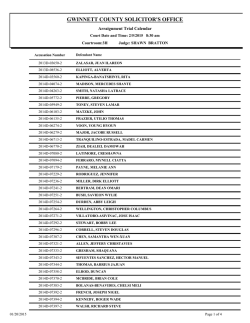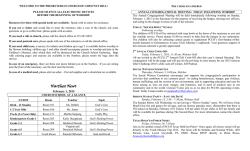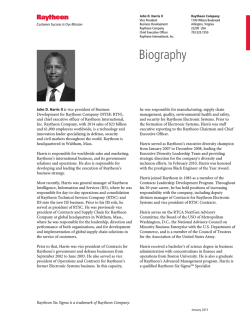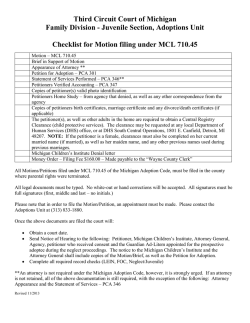
Case Study [pdf] - Opportunity Culture
OPPORTUNITYCULTURE.ORG CHARLOTTE, N.C.’S PROJECT L .I.F.T. R ANSON IB MIDDLE SCHOOL L AUNCHES AN OPPORTUNT Y CULTURE an opportunity culture case study Reach Models in Use Fact File ? Multi-Classroom Leadership ? Time-Technology Swap — ? Project L.I.F.T. (Leadership and Investment for Trans formation) is a public-private partnership to improve academics at historically low-performing, high-need schools in western Charlotte, N.C. Rotation ? Goals include raising West Charlotte High School’s graduation rate from 54 percent in 2011 to 90 percent by 2017, with a focus on its eight feeder schools. ? Ranson Middle School, an International Baccalaureate (IB) ? Watch a brief video: World school, is one of four L.I.F.T. schools implementing new Opportunity Culture school models and roles beginning in 2013–14; the district is scaling up the models into additional schools. Principals from Ranson and Ashley Park schools discuss why they decided to create an Opportunity Culture at their schools. ? ? Ranson was a turnaround school under Alison Harris, who began as its principal in 2011–12. ? In 2012-13, the school had 1,100 students, 74 percent of whom were African-American; 86 percent qualified for free or reduced-price lunch. ? In 2012-13, before Opportunity Culture implementation had begun, 21 percent of the students scored at or above grade level in math, and 25 percent in reading; the school exceeded expected growth according to state standards. summary P rincipal Alison Harris is blunt in describing what she confronted on her arrival to Ranson IB Middle School in 2011. “I was placed in what many people would call an impossible situation,” she says. During her initial visit to the school in 2009–10, she watched as students changed classes—while teachers pressed against the lockers to avoid being run over. “There was a per- vasiveness of disrespect, and no order or purpose.” Ranson needed safety, order, and structure—and then, major academic improvement. After struggling to improve the culture among students and staff, Harris saw the great need to recruit and retain excellent teachers. When she began at Ranson, the school needed 70 teachers. It had 42. She learned from Project L.I.F.T. about Public Impact’s Opportunity Culture initiative—in which schools use job redesign and technology to reach more students with excellent teachers, for more pay, within budget, and to develop all teachers on the job—and decided to bring its possibilities to Ranson. Her school design team eventually settled on two models in combination: using multi-classroom leaders, who lead a team of teachers and take accountability for their students’ outcomes, for far more pay; and time-technology swap teachers (also known as blended- learning teachers), whose students alternate between age- and child-appropriate digital instruction—as little as an hour daily per student—and teaching delivered in person.1 © 2015 p u bl ic i m pac t OpportunityCulture.org 1 Harris allowed one teacher to start his multi-classroom leader role midway through 2012–13, even though other L.I.F.T. schools would not begin implementing the models until the next year. She quickly saw results, and on August 26, 2013, Ranson started a new school year fully staffed, with many more great teachers and a staff committed to its new structure and purpose. This case study looks at the planning for and early days of Ran- son’s Opportunity Culture work. ranson and project l.i.f.t. Ranson belongs to the Project L.I.F.T. zone, a public-private partnership to improve academics at nine historically low- performing, high-need schools in western Charlotte, part of North Carolina’s Charlotte-Mecklenburg School district. L.I.F.T. focuses on West Charlotte High, a school with political and historical significance as an anchor for its community and the focal point of Charlotte’s school de- early steps toward improvement Before Harris was hired, a “strategic staffing” effort to bring in a high-quality leader and five teachers handpicked by that leader had begun in 2007 but did not make enough progress. Among other issues, Harris says, the managed instructional model in use left little autonomy for teachers. Harris had been a Teach For America teacher and also worked as segregation efforts in the 1970s, and its feeder schools, totaling about 7,000 students. Ranson is a fully authorized IB school with a partial magnet, allowing students from outside its attendance zone to come for the IB program. a New Leaders resident principal under Denise Watts, the execu- teachers nationwide produce the learning results—well more than in which teachers felt pride and ownership, and worked to take achievement gaps. The data resonated with Harris, who saw as a tive director of Project L.I.F.T. She wanted to create a school culture teachers out of their “compliance mindset.” “Compliance means folks are constantly watching their back, thinking, ‘When am I going to get called out?’” Instead, by creating new norms for teaching methods, Harris thought she could help teachers feel in charge of a culture of academic achievement. “Adults create the structure and the environment. Many teach- ers worked hard at Ranson,” she says. “But the work was not prioritized or strategic all of the time.” Above all, Harris knew she needed help recruiting and retaining excellent teachers. As a high-need middle school, Ranson had a long history of struggling to find and retain great teachers. a typical year’s worth of growth—that students need to close teacher and leader the impact that great teachers had—and how few teachers actually made that impact, despite trying hard. “Opportunity Culture spoke to me because I interviewed every- one under the sun. At some point, there are no more highly effective people.” But she didn’t immediately warm to the new staffing models to extend great teachers’ reach. “Given my limited experience, I had only seen the traditional one-teacher-one-classroom model,” she says. “My thinking was pushed. I had to expand and open up my mindset.” In taking on the challenge, Harris quickly saw an impact on re- “My first year as principal, I made some not-so-great hiring deci- cruitment and retention. As she and a school design team planned “Kids were without a teacher, and I scrambled to find substitutes.” creating the foundation for an Opportunity Culture, including sions,” leading to four resignations during that year, Harris says. Despite the challenges, Harris saw improvements through the 2012–13 year. Her staff got stronger, teacher attendance went up, and teachers showed more commitment to the school. In 2012–13, what job models to use at Ranson, Harris spent the 2012–13 year making smart hiring decisions with the upcoming Opportunity Culture roles in mind, to bring in strong teachers to fill vacancies. By the end of the year, after recruiting for the new Opportunity just one teacher resigned, for medical reasons; otherwise, “every Culture roles, Harris needed to replace only 10 teachers out of 69— ris says. rest simply wanted to try out other opportunities. teacher who started the year with us ended the year with us,” HarStudent attendance and behavior also improved. Unexcused ab- sences decreased by nearly one day per student, and out-of-school suspension days dropped by nearly two days per student, to an average of 1.74.2 the promise of an opportunity culture and only three of those were not good fits for Ranson, while the For the first time since she arrived, she had no vacancies in math. Harris was able, because of the planning and early success in hiring and retaining staff, to hold an end-of-school retreat to tell teachers what they would be teaching in the fall, improving teacher morale further. “We’ve never been able to do that before,” she says. When Harris began at Ranson, she says, she had only a couple of After Watts decided to give her L.I.F.T. principals the option of be- great teachers whose reach she could have considered extending slides to the principals showing how only the top 25 percent of about 40 percent of the teachers. coming an Opportunity Culture school, Public Impact presented © 2015 p u bl ic i m pac t to more students. Now, she believes she could extend the reach of OpportunityCulture.org 2 And, she says, “I think 85 percent of our staff is now mission- aligned to close the achievement gap,” because of her emphasis that her staff members all need to focus on student growth. “We have to re-envision how we do staffing in the building, so that our time and resources are focused on raising student achievement. Previously, some positions could not tell us how they did this.” ranson’s design team’s choice: teacherleadership, technology In Public Impact’s Opportunity Culture initiative, schools develop new teaching roles, form collaborative teams able to meet dur- ing school hours, and enhance teacher development. Teachers and staff have the opportunity to develop to their full potential through collaboration with and leadership from excellent teachers, and career advancement allows teachers to earn more and help more students. A school design team made up of teachers and administrators With the promise of new Opportunity Culture teaching roles, Ranson Principal Alison Harris saw immediate impacts on recruitment and retention in her highneed, traditionally hard-to-staff school. Based on its resources and greatest needs, Ranson settled on worked through the spring of 2013 leading up to Ranson’s first Op- one multi-classroom leader, and two teachers who would use a follow the five Opportunity Culture Principles. The team analyzed and in-person instruction— in sixth- and seventh-grade math for portunity Culture year to select its new teaching roles, which must detailed data about student performance and teacher effectiveness in the school to identify the biggest needs for improvement Time-Technology Swap—which blends learning through online its first year of implementation. In a Time-Technology Swap, students spend a portion of their and existing assets in its teaching force. It reviewed the range of learning time—as little as an hour per day—engaged in personal- teachers, considering their virtues in light of the school’s needs; time to reach more students. Students learn the basics online, possible staffing models designed to extend the reach of great selected models based on what would enable Ranson to achieve the goal of reaching 80 percent or more of students with excellent teachers by year three of implementation; and planned how to phase the models in over time, taking advantage of Ranson’s ex- isting excellent teachers while adding more over the years through recruitment and professional learning. 1. Reach more students with excellent teachers and their teams 2. P ay teachers more for extending their reach 3. Fund pay within regular budgets 4. Provide protected in-school time and clarity about how to use it for planning, collaboration, and development 5. Match authority and accountability to each person’s responsibilities © 2015 p u bl ic i m pac t allowing excellent teachers to focus their in-person teaching on individualized follow-up and higher-order thinking skills. In a rotation model of a Time-Technology Swap, as Ranson is using, students alternate between digital instruction and an in-person “blended-learning teacher” on a fixed schedule. The blendedlearning teacher receives a $9,200 supplement to the district salary, funded within budget by reallocating other spending at the opportunity culture principles Teams of teachers and school leaders must choose and tailor models to: ized digital instruction, freeing enough of an excellent teacher’s school level. (See “Ensuring Financially Sustainable Higher Pay,” page 6, for details.) Using technology well will be key. “It’s not the technology that changes anything,” Harris says. “It’s the people who use it. Now we can give the right people the right tools they need to accelerate learning.” Contrary to the fear of how technology use will impersonalize a school, one appeal of having blended-learning teachers is how it enables relationships among teachers and students, Harris says. “It’s not the technology that changes anything. It’s the people who use it.” — Alison Harris OpportunityCulture.org 3 “In a high-need urban environment, relationships are critical. Time-Technology Swaps provide opportunities for smaller groups and individualized attention. The kids love it, the teachers love it, and it’s all being driven by data.” Harris especially appreciates how the data coming from the instructional software will help teachers. “Having high-quality teachers, building their skills around data-driven instruction, and using Time-Technology Swaps to extend their reach will completely change the game.” A multi-classroom leader (MCL) is an excellent teacher who leads a team that includes one or more other teachers. The MCL stays in the classroom as a teacher; is accountable for the team’s teaching and the outcomes of all the team’s students; sets the methods and materials used; and collaborates with and develops the team. In 2013–14, the Ranson sixth- and seventh-grade math MCL guided a team of nine teachers and support staff. The MCL re- ceives a $23,000 addition to the district salary. The school and the MCL planned to reconsider after the first year whether this span is the right width, or if the role should be limited to one grade. Harris sees a critical need to extend the reach of her best teach- ers to support more new and developing teachers. When she first taught through Teach For America in 2007, Harris, says, she did not get the support she needed. “I know the power of coaching and supporting teachers. The MCL gives that kind of support.” As with the enhanced relationships among the blended-learn- ing teachers, the MCL’s deep investment in relationships with the teachers in his pod is also intended to effect the culture changes Harris desired at Ranson. Harris planned for MCLs to spend about 20 percent of their time teaching students directly. That leaves 80 percent free to be in their team teachers’ classrooms, giving them real-time feedback, as well as time during the school day to meet a multi-classroom leader’s week As he planned his new role, Romain Bertrand, who par- ticipated on Ranson’s school design team in choosing and planning for the new models, expected a typical week as the MCL to include: ? Two days working directly with students, teaching groups of eight to 10 students who need the most help or are the furthest ahead ? Two days co-teaching with the four team teachers, observing, and providing intensive feedback • All Project L.I.F.T. MCLs have been trained in coaching by the Center for Transformative Teacher Training (CT3). MCLs’ real-time coaching involves using microphones and earpieces to provide immediate feedback to teachers wearing earpieces, so they can adjust their teaching in the moment. • Bertrand will also observe and provide feedback to the blended-learning teachers, to ensure continuity of instruction in all the math classes. ? One day (Friday) working with blended-learning teachers • on long-term plans • to review data from computer lab • to modify weekly lesson plans based on data • on assessment creation and data analysis • to plan student groups for the next week • to plan needed interventions by the MCL or learning coach with teachers to analyze student data together and make plans based on the data and observations. Altogether, this significant amount of team time lays the groundwork for the relationships and culture Harris aims to engender. How Multi-Classroom Leadership Works at Ranson In its first year with the new models operating in sixth- and sev- For students, Harris expects far more individualized teaching. enth-grade math, Ranson had one multi-classroom leader, Romain need small-group intervention, work on digital learning, or [work] (one per grade), four team teachers (two per grade), one EC (ex- same way for a very long time, and it’s just not working. I think this computer lab monitors and interventionists. shift for parents, children, and teachers.” ginning teachers at Ranson for two years, was to focus on the four ing records and their ratings on a set of leadership competencies whole pod. (See more about the selection of the multi-classroom leader in over four class blocks, with newer teachers taking the smaller Paid Teacher-Leader.) their reach to about 145 students a day. “Your performance and mastery will determine whether you Bertrand, who had in his “pod” two blended-learning teachers with a teacher or MCL,” she says. “We have been doing school the ceptional children) teacher, and two learning coaches who act as is going to meet the individual needs of the kids. It’s totally a mind Bertrand, who had been a “facilitator,” coaching math and be- Teachers were selected for these roles based on past teach- team teachers and function as the instructional leader for the based on a highly structured, research-based interview process. The team teachers taught between 100 and 120 students a day Charlotte, N.C.’s Project L.I.F.T.: One Teacher’s View of Becoming a © 2015 p u bl ic i m pac t classes. Blended-learning teachers, meanwhile, each extended OpportunityCulture.org 4 How Time-Technology Swaps Work at Ranson Working with Bertrand’s pod, the blended-learning teachers (BLTs) reach more students in each grade than the team teachers, and reach all the math students through curating and creating online instruction. They get support from from two learning coaches, paraprofessionals who monitor the labs and work with the BLTs on planning. The BLTs are responsible for developing and using the skills of the learning coaches. Learning coaches may pull students out of digital instruction for small-group or individual instruction, based on the BLTs’ instructions and data from the instructional software. As the math multi-classroom leader, Romain Bertrand gets to continue to teach while providing his team teachers with intensive, daily feedback, co-teaching,and co-planning. As the MCL, Bertrand could reach more than 700 students; Ran- BLTs also train the team teachers on digital learning, helping them with flexible student grouping and using the lab and laptops to create digital learning opportunities as needed for students. In a typical week, blended-learning teachers: son’s school design team decided for the first year of implemen- ? Teach four periods a day Monday through Thursday, in math department for grades 6 and 7 because of their faith in Ber- students in their classes, so they can focus on what students tation to have just one multi-classroom leader oversee the entire 75-minute blocks (enabling the team teachers to have fewer trand’s strong instructional leadership. need and the teachers’ strengths). Evaluating and Supporting Multi-Classroom Leaders ? Spend Fridays planning. On that day, the MCL works closely with them to be sure instruction is “vertically aligned,” mak- In the Project L.I.F.T. schools, principals evaluate teachers in new ing it coherent from sixth grade through seventh grade. This ated, using the state’s Professional Teaching Standards evaluation. dent groups and coursework for the following week based bric of “CMS Indicators” and a list of artifacts to collect to help In the 75-minute blocks, students spend part of the time in the Opportunity Culture roles as any other teacher would be evalu- time allows the teachers to study the data and assign stu- Charlotte-Mecklenburg Schools also provides principals with a ru- on that data. guide their teacher ratings. lab and part in the classroom. Higher-achieving students start in “CMS Indicators” for multi-classroom leaders, to provide princi- standings and give them more rigorous work. Lower-achieving stu- L.I.F.T. is working with Public Impact and principals to adapt the pals with guidance and training on evaluating MCLs’ performance both as teachers and teacher-leaders. As noted above, MCLs are accountable for the results of all the students under the teaching teams they lead. the lab, then work directly with teachers to assess any misunderdents start in the classroom with direct instruction, then reinforce what they learn there by practicing the newly taught skills online in the computer lab. “Blended-learning teachers will create different levels of stu- Teachers in all the new roles at the original four participating dent groups that can rotate through the lab at different times,” a regular basis throughout the year to share ideas, solicit specific room stations to allow more digital learning within the classroom, Opportunity Culture schools were placed in a cohort that meets on supports from L.I.F.T., and work together to solve problems. MCLs meet together once a month, and participate in monthly training Bertrand says. In the future, he also expects to use laptops in classto more easily meet students’ needed. Ranson teachers and administrators felt bullish on blended sessions facilitated by L.I.F.T.’s talent partners, focusing on leader- learning based on a test run of Time-Technology Swaps in the team teachers). tive student growth to the fourth-highest growth in the district. ship aspects (such as facilitating planning meetings or coaching L.I.F.T. staff members also serve as coaches to MCLs, frequently going into the schools, observing and giving feedback to MCLs in their roles as teacher-leaders, and L.I.F.T. is developing partnerships with external organizations to provide professional development for MCLs and other new roles. © 2015 p u bl ic i m pac t sixth grade in 2012–13. Ranson’s math program moved from negaIts math growth index score was 8.4 based on the EVAAS growth model, coming in just behind more affluent schools in the district. “Our scholars have experienced it, and they love it,” Harris says. “We have the student achievement data that speaks to the quality of this staffing implementation.” OpportunityCulture.org 5 Evaluating and Supporting Blended-Learning Teachers As noted above for MCLs, blended-learning teachers were to be evaluated as any other teacher would be evaluated, using the state’s Professional Teaching Standards evaluation. Under this system, teachers receive ratings on five standards based on obser- vations of their practice by the school principal and, in the case of early-career teachers, another teacher. On each standard, ratings run from “not demonstrated” to “distinguished.” Teachers also re- ceive a rating on “Standard 6,” focused on the growth achieved by the students in their charge. Blended-learning teachers were to be held accountable under Standard 6 for the growth of all the students they teach (far more than other regular classroom teachers). Project L.I.F.T. will help BLTs use their technology to personal- ize instruction for each student. With Public Impact’s help, L.I.F.T. is showing BLTs how other schools across the country have used blended learning to achieve excellent results. teacher positions for paraprofessionals, who will handle noninstructional and less complex instructional supervision so that no learning value is lost. Or they could convert non-classroom academic facilitator positions, which were originally created to supplement classroom differentiation, into multi-classroom leader positions, as Ranson did—reinvesting in improved classroom in- struction. As a result, all of the CMS pay increases for advanced teaching positions are funded at the school level out of regular funding streams, not temporary grants. None of L.I.F.T.’s philanthropic grants will be needed to fund the pay increases. However, the district could work only with locally funded posi- tions. To implement these pay increases and new roles at scale, it will need to convert state-funded positions as well. But state pay teachers more, potentially limiting its ability to do so in all of At the end of the 2012–13 school year, Ranson teachers were largely, but not entirely, enthusiastic about the coming changes presented to them. Teachers wanted the intensive support that would come from Bertrand, who had seen success over his two years as facilitator. “We focused on how this is going to improve the teachers’ everyday lives,” he says. “This really appealed to inexperienced teachers.” Some experienced teachers, however, reacted with concern initially. “Our most experienced and stronger teachers did not take it the same way,” he says. “There was a bit of fear. The fear is that all of the leadership will be in the hands of three people,” the MCL and BLTs. But Bertrand says the MCLs and BLTs will not take over, but act to boost the efforts of other teachers. “We need to continue what we’ve been doing, which is to rely on the strong teachers. The MCL should not dictate the way you should be teaching every lesson. They [all teachers] should take ownership of their work.” Toward that end, following the expectation Harris set that all teachers should feel responsible for contributing to student achievement, Ranson continued to have professional learning communities, so all teachers plan and problem-solve together. the district’s schools. Ranson decided to go from having four teachers per grade level to three in math—one blended-learning teacher, two team teachers, and a learning coach—in addition to the MCL. “We’ve taken away one teaching position in each grade to fund the learning coach and create the direct support structure of the MCL,” Harris says. “We talked very explicitly with teachers about class sizes.” Teachers needed to understand that although the technical class sizes increased for the blended-learning teachers, effective class sizes, or instructional group sizes, actually decrease—because the BLT is not teaching all the students at once. “We’re not ‘losing’ a teacher, but gaining many other resources to support fewer teachers,” Harris says. Other costs also come into play when implementing these mod- els, but many are one-time or infrequent costs, related to tech- nology and curriculum. As noted, to make an Opportunity Culture financially sustainable, districts must focus on funding the ongo- ing costs of paying teachers within available budgets. But some one-time, transitional costs, such as facilities changes or technology upgrades, may be funded through grants. Ranson has two computer labs, plus 10 laptop carts funded by Title I funds and district support, and the district was able to tweak plans for a recent renovation to add computer infrastructure to the building. Ranson also spent $8,000 of Title I funding for Compass ensuring financially sustainable higher pay Learning, the software that Ranson chose as best for its blended Project L.I.F.T. schools received flexibility and support from the district to reallocate local funds to pay more for teachers in these new © 2015 p u bl ic i m pac t their locally funded positions. For example, they could swap some regulations hampered the district in reallocating state money to Communicating the Changes roles without increasing school budgets. The Opportunity Culture schools chose to “exchange” some of learning math curriculum in sixth and seventh grades. In 2013–14, it will expand that to fifth through eighth grades, as well as Algebra I, costing up to $12,000. OpportunityCulture.org 6 public impact on l.i.f.t.: lessons from the first year Wanting to stay nimble through the early stages of its new mod- els, Ranson leaders expected 2013–14 to be a learning year. “We want to spend a lot more time watching and learning so we can Opportunity Culture Case Studies Charlotte-Mecklenburg Schools’ Project L.I.F.T. Charlotte’s Project L.I.F.T. Flooded with Applications (Note: This reported applications for the 26 positions expected make changes quickly throughout the school year,” Harris says. at that time; the number eventually was reduced to 19 based “We need to continue to stay very relevant, and monitor and con- on the applicants and finalized funding allotments for each tinually make adjustments. It’s important that we don’t ever become complacent, as if we’ve ‘arrived.’” The experience in sixth- and seventh-grade math should serve school.) Opportunity Culture blog as an example for the rest of the school of what an Opportunity news reports and columns on project l.i.f.t.’s adjustments. “We can’t have math 6 and 7 in a silo,” Harris says. (through 2014): transparent to the rest of the school.” Education Week which seemed too large for the first year of implementation, as News and Observer Culture can do for them—showing warts and all, as Ranson makes opportunity culture initiative and ranson “We need to share the changes and mindsets. Math 6–7 has to be WFAE One early lesson was to cut back the size of Bertrand’s pod, the school figured out how best to use an MCL’s time and blended learning. Ranson is considering where to expand these models within the schools as well as what tweaks to make in coming years. Harris hopes to have multi-classroom leaders in all departments, and Bertrand envisions pods of teachers working in each subject and grade level that include a multi-classroom leader, blended-learning teacher, and team teachers. Such a pod creates career opportunities for both excellent and solid, developing teachers. For example, a teacher may first extend his reach through blended learning, then become a multi-class- EdSurge Education Next Learn More about Extending the Reach of Excellent Teachers and Creating an Opportunity Culture for an overview: visit ☞ www.OpportunityCulture.org view ☞ Videos of teachers and administrators working in Opportunity Culture schools across the U.S for more on the models used in this example: visit ☞ Multi-Classroom Leadership room leader. “Steps on the ladder can help attract strong people,” good community to foster their career.” Let Us Know if Your School is Extending Reach and Creating an Opportunity Culture may make for the district overall. c ontact ☞ Public Impact using the Opportunity Culture Bertrand says. For a novice teacher, “this pod could put them in a Meanwhile, Harris appreciates the difference Ranson’s efforts Time-Technology Swap—Rotation feedback form, or e-mail us at “This is going to push people’s thinking. For change to have ef- [email protected]. fect, the leadership needs to be involved,” she says. “It’s not about a program. It’s how we think differently about how we do business”—the business of helping students learn and break out of achievement gaps. Notes Learn More about Project L.I.F.T. and Ranson IB Middle School: project l.i.f.t.: Home page Opportunity Culture information ranson: Home page © 2015 p u bl ic i m pac t 1. For more on the background of CMS and L.I.F.T. creating Opportunity Culture schools, see: Han, J. G., & Barrett, S. K. (2013). Charlotte, N.C.’s Project L.I.F.T.: New teaching roles create culture of excellence in highneed schools. Chapel Hill, NC: Public Impact. Retrieved from http://opportunityculture.org/wp-content/uploads/2013/06/Charlotte_N.C._ Project_L.I.F.T._An_Opportunity_Culture_Case_Study-Public_Impact.pdf 2. See school progress reports at http://www.cms.k12.nc.us/cmsdepartments/accountability/spr/Pages/SchoolProgressReports. aspx?year=2010-2011. At the time of writing, the initiative was too new to evaluate the success of the changes. OpportunityCulture.org 7 How Ranson’s Model Meets the Opportunity Culture Principles Opportunity Culture Principles Ranson’s Model Reach more children with excellent teachers and their teams. ✔ Ranson extends excellent teachers’ reach through its multiclassroom leaders and blended-learning teachers; in 2013–14, its math multi-classroom leader extended his reach to more than 700 students. Pay teachers more for extending their reach. ✔ Multi-classroom leaders and the blended-learning teacher get from $9,200 to $23,000 more for reaching more students. ✔ Ranson, like other Project L.I.F.T. Opportunity Culture schools, can fund its pay increases through savings within its existing budget, by exchanging an academic facilitator position for a multi-classroom leader, and swapping one teaching position in each grade for learning coaches. (Doing this district-wide within CMS will require more flexibility in spending of state funds and other stable sources of money.) ✔ Blended-learning teachers and team teachers have set-aside time to plan with their MCL, reviewing student data and adjusting instructional groups. The MCL has days set aside to teach, coach, and co-plan. ✔ Multi-classroom leaders are held accountable for the results of all the students in their pod, and blended-learning teachers are accountable for all the students they reach; Project L.I.F.T. is working to formalize accountability reporting. Fund pay within regular budgets. Provide protected in-school time and clarity about how to use it for planning, collaboration and development. Match authority and accountability to each person’s responsibilities. Acknowledgements This case study was co-authored by Sharon Kebschull Barrett and Jiye Grace Han. For a list of funders of the Opportunity Culture publications and website, see here. The statements made and views expressed are solely the responsibility of Public Impact. For more information about the Opportunity Culture initiative, visit OpportunityCulture.org. Public Impact encourages the sharing and copying of these materials. Users must include “©2015 Public Impact” and “OpportunityCulture.org” on all pages where material from this document appears. © 2015 p u bl ic i m pac t Please cite this report as: Public Impact: Barrett, S. K., & Han, J. G. (2015). Charlotte, N.C.’s Project L.I.F.T.: Ranson IB middle school launches an opportunity culture. Chapel Hill, NC: Public Impact. Retrieved from http:// opportunityculture.org/wp-content/uploads/2015/01/Charlotte_NCs_ Project_LIFT_Ranson_Launches_An_Opportunity_Culture-Public_Impact.pdf building an opportunity culture for america’s teachers OpportunityCulture.org 8
© Copyright 2025






